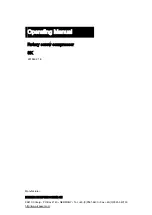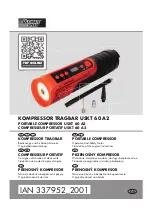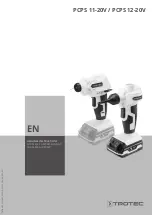
6
5
#('6;
&74+0)
64#052146
#0&
+056#..#6+10
To lift a unit, all loose or pivoting parts, e.g. doors and towbar, shall first be
securely fastened.
Do not attach cables, chains or ropes directly to the lifting eye; apply a crane
hook or lifting shackle meeting local safety regulations. Never allow sharp
bends in lifting cables, chains or ropes.
Helicopter lifting is not allowed.
It is strictly forbidden to dwell or stay in the risk zone under a lifted load.
Never lift the unit over people or residential areas. Lifting acceleration and
retardation shall be kept within safe limits.
1
Before towing the unit:
- ascertain that the pressure vessel(s) is (are) depressurized,
- check the towbar, the brake system and the towing eye. Also check
the coupling of the towing vehicle,
- check the towing and brake capability of the towing vehicle,
- check that the towbar, jockey wheel or stand leg is safely locked in
the raised position,
- ascertain that the towing eye can swivel freely on the hook,
- check that the wheels are secure and that the tyres are in good
condition and inflated correctly,
- connect the signalisation cable, check all lights and connect the
pneumatic brake couplers,
- attach the safety break-away cable or safety chain to the towing
vehicle,
- remove wheel chocks, if applied, and disengage the parking brake.
2
To tow a unit use a towing vehicle of ample capacity. Refer to the
documentation of the towing vehicle.
3
If the unit is to be backed up by the towing vehicle, disengage the
overrun brake mechanism (if it is not an automatic mechanism).
4
Never exceed the maximum towing speed of the unit (mind the local
regulations).
5
Place the unit on level ground and apply the parking brake before
disconnecting the unit from the towing vehicle. Unclip the safety break-
away cable or safety chain. If the unit has no parking brake or jockey
wheel, immobilize the unit by placing chocks in front of and/or behind
the wheels. When the towbar can be positioned vertically, the locking
device must be applied and kept in good order.
6
To lift heavy parts, a hoist of ample capacity, tested and approved
according to local safety regulations, shall be used.
7
Lifting hooks, eyes, shackles, etc., shall never be bent and shall only
have stress in line with their design load axis. The capacity of a lifting
device diminishes when the lifting force is applied at an angle to its load
axis.
8
For maximum safety and efficiency of the lifting apparatus all lifting
members shall be applied as near to perpendicular as possible. If
required, a lifting beam shall be applied between hoist and load.
9
Never leave a load hanging on a hoist.
10 A hoist has to be installed in such a way that the object will be lifted
perpendicular. If that is not possible, the necessary precautions must be
taken to prevent load-swinging, e.g. by using two hoists, each at
approximately the same angle not exceeding 30° from the vertical.
11 Locate the unit away from walls. Take all precautions to ensure that hot
air exhausted from the engine and driven machine cooling systems
cannot be recirculated. If such hot air is taken in by the engine or driven
machine cooling fan, this may cause overheating of the unit; if taken in
for combustion, the engine power will be reduced.
5
#('6;
&74+0)
75'
#0&
12'4#6+10
1
When the unit has to operate in a fire-hazardous environment, each
engine exhaust has to be provided with a spark arrestor to trap
incendiary sparks.
2
The exhaust contains carbon monoxide which is a lethal gas. When the
unit is used in a confined space, conduct the engine exhaust to the
outside atmosphere by a pipe of sufficient diameter; do this in such a
way that no extra back pressure is created for the engine. If necessary,
install an extractor. Observe any existing local regulations. Make sure
that the unit has sufficient air intake for operation. If necessary, install
extra air intake ducts.
3
When operating in a dust-laden atmosphere, place the unit so that dust is
not carried towards it by the wind. Operation in clean surroundings
considerably extends the intervals for cleaning the air intake filters and
the cores of the coolers.
4
Close the compressor air outlet valve before connecting or
disconnecting a hose. Ascertain that a hose is fully depressurized before
disconnecting it. Before blowing compressed air through a hose or air
line, ensure that the open end is held securely, so that it cannot whip and
cause injury.
5
The air line end connected to the outlet valve must be safeguarded with
a safety cable, attached next to the valve.
6
No external force may be exerted on the air outlet valves, e.g. by pulling
on hoses or by installing auxiliary equipment directly to a valve, e.g. a
water separator, a lubricator, etc. Do not step on the air outlet valves.
7
Never move a unit when external lines or hoses are connected to the
outlet valves, to avoid damage to valves, manifold and hoses.
8
Do not use compressed air from any type of compressor, without taking
extra measures, for breathing purposes as this may result in injury or
death. For breathing air quality, the compressed air must be adequately
purified according to local legislation and standards. Breathing air must
always be supplied at stable, suitable pressure.
9
Distribution pipework and air hoses must be of correct diameter and
suitable for the working pressure. Never use frayed, damaged or
deteriorated hoses. Replace hoses and flexibles before the lifetime
expires. Use only the correct type and size of hose end fittings and
connections.
10 If the compressor is to be used for sand-blasting or will be connected to
a common compressed-air system, fit an appropriate non-return valve
(check valve) between compressor outlet and the connected sand-
blasting or compressed-air system. Observe the right mounting position/
direction.
11 Before removing the oil filler plug, ensure that the pressure is released
by opening an air outlet valve.
12 Never remove a filler cap of the cooling water system of a hot engine.
Wait until the engine has sufficiently cooled down.
13 Never refill fuel while the unit is running, unless otherwise stated in the
Atlas Copco Instruction Book (AIB). Keep fuel away from hot parts
such as air outlet pipes or the engine exhaust. Do not smoke when
fuelling. When fuelling from an automatic pump, an earthing cable
should be connected to the unit to discharge static electricity. Never spill
nor leave oil, fuel, coolant or cleansing agent in or around the unit.
Summary of Contents for XA146 Dd
Page 2: ... 5 5 2 ...







































